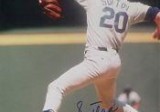Pineda's Elbow Level (3)
 Q. If a pitcher had a higher-stress motion, would that mean he was going to get hurt?
Q. If a pitcher had a higher-stress motion, would that mean he was going to get hurt?
A. No. You put a 350-lb. barbell on my shoulders, at 48, and it would probably injure my back.
You put a 450-lb. barbell on Chris Spencer's shoulders, and that's a higher-stress situation in the absolute ... but Spencer isn't going to get hurt. He's stronger and more resilient than I am.
Merely saying that Tuffy Tufferson has a higher-stress movement doesn't mean that Tuffy will get hurt. We're multiplying two things: [Stress load x Personal resilience]. (And time, reps, comes in as factor #3.)
Right?
Chris Spencer can handle a 450-lb. squat with ease. I can't. .... Felix Hernandez can handle a 96-mph fastball motion with ease. Mark Prior can't.
.
However stressful a motion is, it's one of many factors. Height, weight, the genetics of the ligaments etc., the fastball velocity, the RH vs LH, etc etc.
Anybody can get hurt, but there's 100 years of baseball intuition behind the "big hoss" throwing hard. Walter Johnson, Tom Seaver, Roger Clemens, Curt Schilling, Felix Hernandez. Draw your own conclusions as to where Michael Pineda fits in.
Again: pitching is unnatural. I expected Felix to probably get hurt by now. But Michael Pineda vs. Ian Snell? I'll take Swamp-Thing.
.
Of course, it's hard for us to be sure of what we're seeing, anyway. If a Mariners' prospect came up and we saw him in Don Sutton's position, at foot plant, I'm sure we'd call that a poor throwing motion.
There have been six or seven RHP's with 5,000 IP since WWII, and probably half of them had "high elbows at foot plant."
.
Q. How do these factors break down on Pineda?
A. Let's say that SSI were playing an Ultra league, and had to bet the farm on .... Aroldis Chapman, Jeremy Hellickson, Mauricio Robles, Kyle Gibson, Michael Pineda...
Here are the injury factors, IN ORDER, as SSI would apply them to Pineda.
- Velocity and K's - big plus. Most important separator. K's = health.
- Body Shape - big plus. Huge, strong, with a loose arm. Pineda is Chris Spencer lifting weights (throwing fastballs), rather than Deion Branch lifting weights.
- Mechanics - a minus for me. Much more max-effort, less leveraged, than I'd like. (As with the young Clemens.)
- Shape of Pitches - a big plus.
- History - about average. Some elbow tenderness. Par for the course.
- Workload - who knows. Pineda's been used lightly. Don't know if that's good. For the M's, it doesn't seem to have been. I guess it's a plus that he hasn't been thrashed.
- Age and Handedness - a minus. Any 22-year-old RHP figures to get hurt. You'd rather have a 32-year-old lefty than a 22-year-old righty.
Overall? Certainly it isn't a guy I trade because he's a catastrophe waiting to happen. As pitching prospects go, Michael Pineda is the one guy you hope to produce every 5-10 years.
Which still doesn't make him a guarantee. How scared are you about Pineda's future? = how scared you are about elite young pitchers generally. Good inkblot test.
.
Q. Dr's Prognosis?
A. I don't remember seeing anybody, with Pineda's max-effort motion, going 5,000 innings. If Pineda wants to pitch for 15-20 years, I would think his mechanics would have to evolve.
That said, over the next 5 years, I'll take Pineda along with anybody else in his peer group.
.
Cheerio,
Dr D